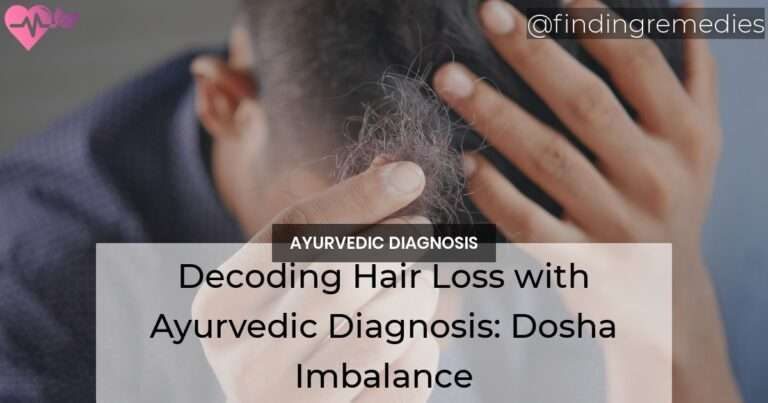Hair loss is one of the most common and distressing issues faced by people today. Whether it’s a receding hairline, thinning crown, or bald spots, it’s easy to blame the problem on genetics or aging. But what if the issue is deeper than that? Ayurvedic diagnosis offers an ancient method of understanding the underlying causes of hair loss, helping us to decode the dosha imbalance and restore balance to the body and mind.
In this article, we’ll look at how Ayurveda views hair loss, and how to identify the root cause of the problem. We’ll also explore the different treatments and remedies available to restore balance and promote hair growth. So if you’re looking for a natural way to tackle your hair loss, read on to discover the power of Ayurvedic diagnosis.
Table of Contents
Hair Loss in Ayurveda
Hair loss is a common concern among both men and women. While it may seem like a purely cosmetic issue, hair loss can also be an indicator of deeper imbalances in the body. In Ayurveda, hair loss is seen as a manifestation of dosha imbalance, meaning that the root cause of hair loss lies in an imbalance of Vata, Pitta, or Kapha doshas.
Understanding Dosha Imbalance and Hair Loss
According to Ayurveda, each person has a unique balance of the three doshas, Vata, Pitta, and Kapha, within their body. When these doshas become imbalanced, it can lead to a variety of physical and emotional symptoms, including hair loss.
Vata imbalance can cause hair to become dry and brittle, leading to breakage and hair loss. Pitta imbalance can cause inflammation in the scalp, leading to premature hair loss. An excess of Kapha dosha can cause the hair follicles to become clogged, preventing healthy hair growth.
Importance of Ayurvedic Diagnosis for Hair Loss
In order to address hair loss from an Ayurvedic perspective, it is important to first identify the underlying dosha imbalance. This can be done through Ayurvedic diagnosis techniques such as Nadi Pariksha, tongue examination, and pulse diagnosis. By understanding the root cause of the hair loss, an individualized treatment plan can be created to address the specific dosha imbalance in each person.
The Three Doshas
Vata Dosha:
- Dry, brittle hair
- Hair that breaks easily
- Flaky scalp
- Increased hair loss during colder months
Pitta Dosha:
- Premature greying of hair
- Thinning hair
- Inflammation in the scalp
- Increased hair loss during hotter months
Kapha Dosha:
- Excessive oiliness in hair
- Clogged hair follicles
- Slow hair growth
- Increased hair loss during damp, humid weather
Ayurvedic Diagnosis of Hair Loss
Nadi Pariksha:
This is a diagnostic technique in which a trained Ayurvedic practitioner reads the pulse to determine the balance of the doshas in the body. By analyzing the pulse, the practitioner can identify any imbalances that may be contributing to hair loss.
Tongue Examination:
The tongue can also provide important clues about dosha imbalances in the body. An Ayurvedic practitioner will examine the color, texture, and coating of the tongue to determine any underlying imbalances.
Pulse Diagnosis:
Similar to Nadi Pariksha, this diagnostic technique involves reading the pulse to identify imbalances in the doshas.
Ayurvedic Treatment for Hair Loss
Herbal Remedies for Hair Loss:
- Amla: Rich in vitamin C and antioxidants, amla can help nourish the hair and promote healthy hair growth.
- Bhringraj: Known as the “king of herbs” for hair, bhringraj can help strengthen hair follicles and prevent hair loss.
- Brahmi: This herb helps to improve blood circulation, which can promote healthy hair growth.
Ayurvedic Scalp Treatment:
- Warm Oil Scalp Massage: A warm oil scalp massage can help nourish the scalp and hair follicles, promoting healthy hair growth.
- Shirodhara: This Ayurvedic therapy involves pouring warm oil over the forehead and scalp, helping to release stress and tension that may be contributing to hair loss.
Ayurvedic Lifestyle Changes to Prevent Hair Loss
Diet and Nutrition:
- Eat a balanced diet rich in whole foods and nutrients that support healthy hair growth, such as protein, iron, and vitamin C.
- Avoid processed foods and excess sugar, which can contribute to inflammation in the body and scalp.
Yoga and Exercise:
- Engage in regular exercise and yoga to improve circulation and reduce stress, both of which can help prevent hair loss.
Stress Management Techniques:
- Practice relaxation techniques such as meditation, deep breathing, and yoga to reduce stress levels, which can contribute to hair loss.
In conclusion, by understanding the dosha imbalances that can contribute to hair loss and utilizing Ayurvedic diagnosis techniques, herbal remedies, and lifestyle changes, it is possible to prevent and treat hair loss from an Ayurvedic perspective. With a holistic approach that addresses the root cause of hair loss, individuals can promote healthy hair growth and maintain a healthy dosha balance for overall health and wellbeing.

